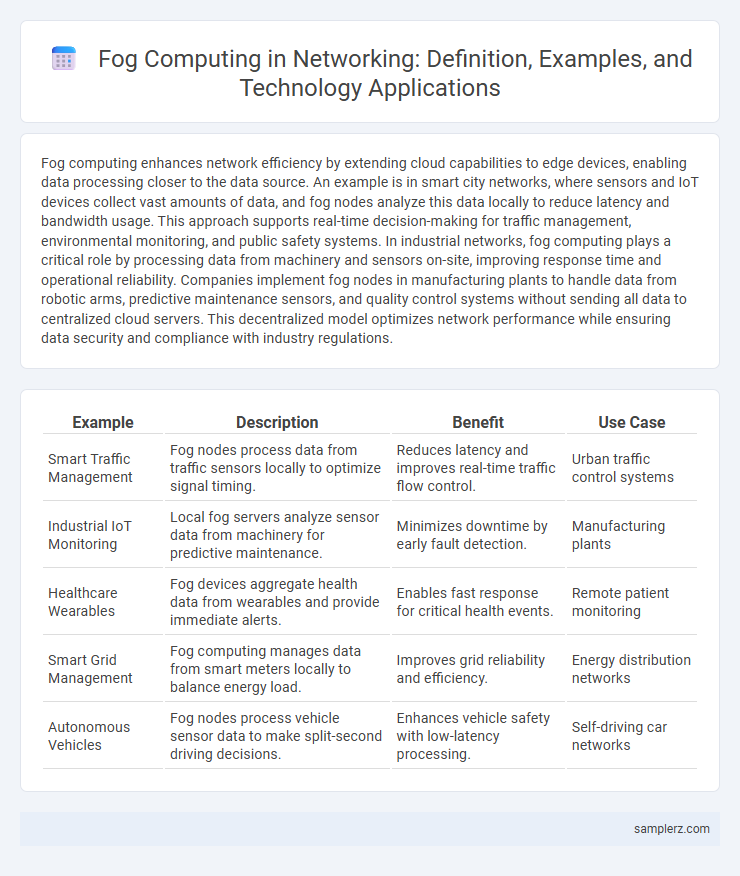Fog computing enhances network efficiency by extending cloud capabilities to edge devices, enabling data processing closer to the data source. An example is in smart city networks, where sensors and IoT devices collect vast amounts of data, and fog nodes analyze this data locally to reduce latency and bandwidth usage. This approach supports real-time decision-making for traffic management, environmental monitoring, and public safety systems. In industrial networks, fog computing plays a critical role by processing data from machinery and sensors on-site, improving response time and operational reliability. Companies implement fog nodes in manufacturing plants to handle data from robotic arms, predictive maintenance sensors, and quality control systems without sending all data to centralized cloud servers. This decentralized model optimizes network performance while ensuring data security and compliance with industry regulations.
Table of Comparison
| Example | Description | Benefit | Use Case |
|---|---|---|---|
| Smart Traffic Management | Fog nodes process data from traffic sensors locally to optimize signal timing. | Reduces latency and improves real-time traffic flow control. | Urban traffic control systems |
| Industrial IoT Monitoring | Local fog servers analyze sensor data from machinery for predictive maintenance. | Minimizes downtime by early fault detection. | Manufacturing plants |
| Healthcare Wearables | Fog devices aggregate health data from wearables and provide immediate alerts. | Enables fast response for critical health events. | Remote patient monitoring |
| Smart Grid Management | Fog computing manages data from smart meters locally to balance energy load. | Improves grid reliability and efficiency. | Energy distribution networks |
| Autonomous Vehicles | Fog nodes process vehicle sensor data to make split-second driving decisions. | Enhances vehicle safety with low-latency processing. | Self-driving car networks |
Real-Time Traffic Management Using Fog Computing
Real-time traffic management systems leverage fog computing to process data locally at the network edge, significantly reducing latency and enabling faster decision-making for traffic signal control and congestion monitoring. By deploying fog nodes near intersections and roadways, sensors and cameras transmit immediate data, allowing adaptive traffic flows and improved emergency response times. This decentralized approach enhances network efficiency and reliability compared to cloud-centric solutions, optimizing urban mobility and reducing traffic-related delays.
Smart Healthcare Monitoring with Fog Networks
Fog computing enhances smart healthcare monitoring by processing patient data locally on fog nodes, reducing latency and enabling real-time health analytics. Wearable devices collect vital signs such as heart rate and oxygen levels, transmitting data to nearby fog nodes for immediate analysis and anomaly detection. This decentralized approach improves response times in critical situations and optimizes bandwidth by minimizing data sent to centralized cloud servers.
Industrial Automation Powered by Fog Computing
Industrial automation leverages fog computing by processing data locally at the network edge, significantly reducing latency and enhancing real-time decision-making for machinery control. Fog nodes facilitate seamless integration of sensors, actuators, and control systems, enabling predictive maintenance and minimizing downtime in manufacturing environments. This decentralized architecture improves operational efficiency and supports scalable, low-latency communication within complex industrial IoT networks.
Smart Grid Optimization through Fog Nodes
Fog computing enhances Smart Grid Optimization by deploying fog nodes close to data sources, enabling real-time processing of energy consumption and grid status. These fog nodes reduce latency and bandwidth usage by filtering and analyzing data locally before sending critical insights to centralized cloud systems. This approach improves grid reliability, demand response efficiency, and supports dynamic load balancing in smart energy networks.
Video Surveillance and Analytics at the Edge
Fog computing in video surveillance and analytics at the edge enables real-time processing of video feeds directly on local devices, reducing latency and bandwidth usage. By deploying fog nodes near cameras, systems can perform immediate object detection, motion analysis, and threat identification without relying on centralized cloud servers. This approach enhances security response times and optimizes network traffic for large-scale surveillance networks.
Fog Computing in Connected Vehicle Networks
Fog computing enhances connected vehicle networks by processing data closer to the source, such as roadside units and onboard sensors, reducing latency and improving real-time decision making. In intelligent transportation systems, fog nodes analyze traffic patterns and vehicle telemetry to optimize route planning and safety alerts. This decentralized approach supports scalable, low-latency vehicle-to-everything (V2X) communication, critical for autonomous driving and smart city infrastructure.
Enhancing IoT Performance with Fog Architecture
Fog computing enhances IoT performance by decentralizing data processing closer to network devices, reducing latency and bandwidth usage. This architecture supports real-time analytics and faster decision-making for applications like smart grids, autonomous vehicles, and industrial automation. By distributing computation across fog nodes, networks achieve improved scalability and reliability, critical for managing the exponential growth of connected IoT devices.
Energy-Efficient Smart Homes with Fog Computing
Fog computing enhances energy-efficient smart homes by processing data locally on edge devices, reducing latency and minimizing energy consumption compared to cloud-only solutions. Smart thermostats and lighting systems utilize fog nodes to analyze real-time sensor data, optimizing power usage and adapting to occupant behavior dynamically. This decentralized architecture supports sustainable energy management and improves responsiveness in home automation networks.
Environmental Monitoring via Fog-Enabled Sensors
Fog computing enhances environmental monitoring by deploying fog-enabled sensors that process data locally, reducing latency and bandwidth usage compared to cloud-only solutions. These sensors collect real-time data on air quality, temperature, and humidity, enabling rapid analysis and response to environmental changes. Integrating fog nodes with IoT devices supports scalable, energy-efficient networks crucial for sustainable urban and agricultural ecosystems.
Disaster Response Networks Leveraging Fog Computing
Disaster response networks leverage fog computing to enable low-latency data processing and real-time analytics at the network's edge, improving situational awareness during emergencies. By deploying fog nodes near affected areas, critical data from IoT sensors and drones is processed locally, reducing dependence on centralized cloud infrastructure and enhancing communication reliability. This approach supports faster decision-making and resource allocation in disaster zones, optimizing rescue operations and minimizing downtime.

example of fog computing in network Infographic
 samplerz.com
samplerz.com